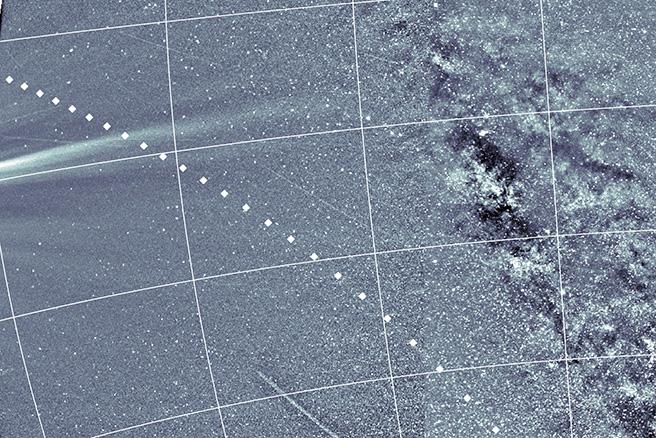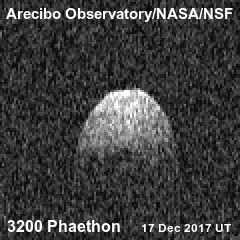The expected peak of 2023’s’s Geminid meteor shower is around December 13 and 14. This year, a thin waxing crescent moon will be gone long before the peak viewing time (around 2 a.m.) of the meteors. The Geminid’s radiant point rises in mid-evening, so you can start watching earlier at night than most meteor showers! Read more about 2023’s Geminid meteor shower.
Weirdly comet-like 3200 Phaethon
Most meteors in annual showers have comets as their sources. But not December’s Geminid meteors, whose source, known as 3200 Phaethon, is a strange hybrid of an asteroid and a comet. This “rock-comet” isn’t icy, like a comet is. But it’s known to brighten as it nears the sun, as comets do. And it has a tail. Plus, it spawns the Geminid meteor shower. And so scientists have long puzzled over 3200 Phaethon. How can a rocky asteroid leave behind debris that sparks a meteor shower? Where does its tail come from?
Scientists continue to find answers to how this asteroid can produce one of the year’s best meteor showers.
Available now! 2024 EarthSky lunar calendar. A unique and beautiful poster-sized calendar showing phases of the moon every night of the year. Makes a great gift!
New research on 3200 Phaethon
On November 28, 2023, a team at the University of Helsinki released a press release linking a rare type of meteorite to the asteroid 3200 Phaethon. They based their findings on a study published in the journal Nature Astronomy on November 2, 2023.
Researchers at the University of Helsinki compared an infrared spectrum of 3200 Phaethon – from NASA’s Spitzer space telescope – to infrared spectra of known meteorites. They found Phaethon’s spectrum showed olivine, carbonates, iron sulfides, and oxide minerals were all present in the asteroid. And that matches the composition of CY carbonaceous chondrite meteorites. These are rare types of meteorites with only six samples available for study.
When they expose CY meteorites to high temperatures – like those when 3200 Phaethon passes near the sun – the carbonates in the meteorites produce carbon dioxide, releasing water vapor, and the sulfides release sulfur gas.
While these findings may explain how 3200 Phaethon releases gas near the sun, what about the dust and cometary debris that results in the Geminid meteor shower?
How the cometary debris might form
According to their study:
The researchers used experimental data from other studies in conjunction with their thermal models, and, based on them, it was estimated that when the asteroid passes closest to the sun, gas is released from the mineral structure of the asteroid, which can cause the rock to break down. In addition, the pressure produces by carbon dioxide and water vapor is high enough to lift small dust particles from the surface of the asteroid.
Their lead author, postdoctoral researcher Eric MacLennan from the University of Helsinki said:
Sodium emission can explain the weak tail we observe near the sun, and thermal decomposition can explain how dust and gravel are released from Phaethon.
And associate professor Mikael Granvik from the University of Helsinki summed it up:
It was great to see how each one of the discovered minerals seemed to fall into place and also explain the behavior of the asteroid.
Their study also ties in with previous findings released by NASA in 2021.
NASA found sodium coming off 3200 Phaethon’s surface
On August 16, 2021, scientists with NASA’s Jet Propulsion Laboratory in Pasadena, California, announced a possible explanation to 3200 Phaethon’s comet-like behavior. Part of the answer might be sodium fizzing from the asteroid’s surface. Their statement explained that this asteroid:
… brightens as it gets close to the sun. Comets typically behave like this: When they heat up, their icy surfaces vaporize, causing them to become more active and brighten as the venting gases and dust scatter more sunlight. But what is causing Phaethon to brighten if not vaporizing ices?
The culprit could be sodium. As the new study’s authors explain, Phaethon’s elongated, 524-day orbit takes the object well within the orbit of Mercury, during which time the sun heats the asteroid’s surface up to about 1,390 F (750 C). With such a warm orbit, any water, carbon dioxide or carbon monoxide ice near the asteroid’s surface would have baked off long ago. But, at that temperature, sodium may be fizzing from the asteroid’s rock and into space.
Sodium in the mix
Astronomer Joe Masiero of IPAC at Caltech was lead author of this study. He said:
We know it’s an asteroid and the source of the Geminids. But it contains little to no ice, so we were intrigued by the possibility that sodium, which is relatively plentiful in asteroids, could be the element driving this activity.

Inspired by the Geminid meteors
Masiero and his team said observations of Geminid meteors inspired them. Their statement explained:
When meteoroids – small pieces of rocky debris from space – streak through Earth’s atmosphere as meteors, they disintegrate. But before they do, friction with the atmosphere causes the air surrounding the meteoroids to reach thousands of degrees, generating light. The color of this light represents the elements they contain. Sodium, for example, creates an orange tinge. The Geminids are known to be low in sodium.
Until now, it was assumed that these small pieces of rock somehow lost their sodium after leaving the asteroid. This new study suggests that the sodium may actually play a key role in ejecting the Geminid meteoroids from Phaethon’s surface.
[We] think that as the asteroid approaches the sun, its sodium heats up and vaporizes. This process would have depleted the surface of sodium long ago, but sodium within the asteroid still heats up, vaporizes, and fizzes into space through cracks and fissures in Phaethon’s outermost crust. These jets would provide enough oomph to eject the rocky debris off its surface.
So the fizzing sodium could explain not only the asteroid’s cometlike brightening, but also how the Geminid meteoroids would be ejected from the asteroid and why they contain little sodium.
Sodium dislodges particles
Björn Davidsson of NASA’s Jet Propulsion Laboratory was a co-author of the study. He added:
Asteroids like Phaethon have very weak gravity, so it doesn’t take a lot of force to kick debris from the surface or dislodge rock from a fracture. Our models suggest that very small quantities of sodium are all that’s needed to do this. It’s nothing explosive, like the erupting vapor from an icy comet’s surface. It’s more of a steady fizz.
Read more: Fizzing Sodium Could Explain Asteroid Phaethon’s Cometlike Activity
All that, and blue, too
By the way, the comet-like behavior of this asteroid isn’t the only unusual thing about it. For one thing, 3200 Phaethon has an odd color for an asteroid. Most asteroids are dull grey to red, depending on the type of material on their surface. 3200 Phaethon is blue. Blue asteroids are known, but make up only a fraction of all known asteroids. And Phaethon isn’t just blue. It’s one of the bluest of similarly colored asteroids (or comets) in the solar system.
Here’s another odd feature of 3200 Phaethon. While comets tend to have more elliptical orbits, asteroid orbits are more circular. 3200 Phaethon’s orbit – which is now exceedingly well known – is highly elongated, reminiscent of some comets. Its orbit crosses the orbits of Mars, Earth, Venus and Mercury.
Plus, its orbit brings 3200 Phaethon closer to the sun than any other named asteroid (though some smaller, unnamed asteroids come even closer). At its closest point, Phaethon is only 13 million miles (20.9 million km) from the sun. That’s less than half of Mercury’s closest distance.
The name of this object – 3200 Phaethon – honors its relationship to the sun. In Greek mythology, Phaethon was the son of the sun god Helios.
A potentially hazardous asteroid
3200 Phaethon is classified as a potentially hazardous asteroid. But that doesn’t mean it’s a threat to Earth. It just means two things. First, 3200 Phaethon is big. The latest estimates (2021) suggest it’s 3.6 miles (5.8 km) wide. It’s big enough to cause significant regional damage if it were to strike Earth. Second, it’s known to make periodic close approaches to Earth. But astronomers know of no upcoming strike by this object in the foreseeable future.
In 2017, 3200 Phaethon came closer to Earth than it will again until 2093. At its closest in 2017, it was still about 26 times the moon’s distance away.
Videos of 3200 Phaethon
Both amateur and professional astronomers watched 3200 Phaethon as carefully as they could in 2017. For example, Northolt Branch Observatories in London, England, created the animation below from images it captured in 2017.
Steven Bellavia also produced a video (below) of 3200 Phaethon in 2017. He commented then that he’d endured cloudy weather and subfreezing temperatures in order to capture the images.

The history of 3200 Phaethon
3200 Phaethon was the first asteroid discovered via spacecraft, on October 11, 1983. Astronomers Simon F. Green and John K. Davies noticed it while searching Infrared Astronomical Satellite data for moving objects. Charles T. Kowal confirmed it optically and said it was asteroid-like in appearance. The object received the provisional designation 1983 TB. Two years later, in 1985, using the convention for naming asteroids, astronomers assigned it its asteroid number and name: 3200 Phaethon.
Before 3200 Phaethon, scientists linked all known meteor showers to comets and not asteroids.
Thus, 3200 Phaethon surprised them from the beginning, because – while it looked like an asteroid – it appeared to be the source of the annual Geminid meteor shower. Astronomers began calling 3200 Phaethon a comet-asteroid hybrid, an asteroid that behaves like a comet. Later, they began using the term rock-comet.
What else will we learn about this object, as the years pass?
Bottom line: The Geminid meteor shower has a unique source – 3200 Phaethon – sometimes called a comet-asteroid hybrid, or a rock-comet. In November 2023, scientists found the composition of 3200 Phaethon matches a rare type of meteorite that releases gas when heated to temperatures like 3200 Phaethon experiences when it nears the sun. And in 2021, scientists suggested that some of this object’s comet-like behavior might stem from sodium fizzing from its surface.
Source: Thermal decomposition as the activity driver of near-Earth asteroid (3200) Phaethon
Via University of Helsinki
Via JPL
Via U.S. Naval Research Lab